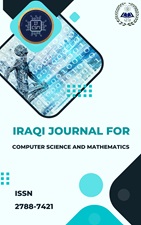The Iraqi Journal for Computer Science and Mathematics, established in 2020, is a distinguished, peer-reviewed open-access publication issued four times a year by the College of Education at Aliraqia University. Dedicated to advancing the frontiers of computer science, mathematics, computer engineering, and statistics, the journal provides a platform for researchers to share their groundbreaking work with a global audience.
By emphasizing rigorous single-blind peer review and rapid publication within an average of two months, it ensures timely dissemination of innovative research findings. The journal's commitment to full open access removes financial barriers, making knowledge accessible to a wider scholarly community. Aligning with Aliraqia University's mission, it contributes to the development of a robust scientific landscape in Iraq and beyond. The journal accepts various types of articles, including original research, review articles, and editorial papers, and is indexed in Scopus, DOAJ, and Iraqi academic journals. Iraqi Journal for Computer Science and Mathematics.
See the Aims and Scope for a complete coverage of the journal.
Current Issue: Volume 6, Issue 4 (2025)
Original Studies
Study of ~-Topological Space by ~-Binary Relation in Cluster System
Mustafa Hasan Hadi and Luay Abd Al haine Al swidi
Analysis of Energy Sector CO2 Emanations Using Wavelet-Based Numerical Technique
Yeshwanth R. and Kumbinarasaiah S.
A Robust and Energy-Efficient Federated IDS for IIoT Using Spiking Neural Networks and Differential Evolution with Adversarial Resilience
Mohammad Othman Nassar
A Novel Hybrid Intrusion Detection Model: A New Metaheuristic Approach for Feature Selection Based on AI Techniques for Cyber Threat Detection
Maryam Mahdi Alhusseini and Alireza Rouhi
Recognition of Bangla and English Words in Bengali Texts Using a Modified BERT-base-NER Model
Md Parvez Hossain, Ohidujjaman Ohidujjaman, Mohammad Shorif Uddin, Mohammad Nurul Huda, and Tetsuya Shimamura
An Enhanced Cyber Security for Finger Knuckle Print Recognition System Using Rubik’s Cube with Rabbit Encryption Algorithm
Haitham Salman Chyad and Tarek Abbes
Blind Medical Image Watermarking Method Using Combined NSCT/2D-DCT Domains
Ali Kouadri, Ali Benziane, Abdelhalim Rabehi, and Mohamed Lebcir
AI-Driven Flood Prediction, Monitoring, and Warning Systems: Design, Evaluation, and Simulation
Abdel Rahman A. Alkharabsheh and Lina M. Momani
Artificial Intelligence in Higher Education: Opportunities and Challenges
Maytha AL-Ali, Adam Marks, Jasur Umirzokov, and Noura Metawa
MultiTaskVenationNet: A Multi-Task Deep Neural Network with Strip Pooling and Hybrid Upsampling for Leaf Vein Segmentation
Ishak Ariawan, Ahmad Ashari, and Moh. Edi Wibowo
Deep Learning-Based Fog-Cloud Approach Intrusion Detection System in IoMT
Yahya Rbah, Mohammed Mahfoudi, Mohammed Fattah, Younes Balboul, Said Mazer, and Moulhime Elbekkali
Improving Road Safety Through Multimodal Deep Learning for Driver Drowsiness Detection
Hadel A. Hussain, Mohammed A. Subhi, Ahmed S. Al Tmeme, Ahmed D. Radhi, and Marwan Ali Albahar
Application of Adversarial Volumetric CNNs to 3D Face Generation Using Latent Space Gaussian Embeddings
Ali Raad Abdulkareem, Marwa Jabberi, Islem Jarraya, Tarek M. Hamdani, Khmaies Ouahada, and Adel M. Alimi
A Proposed Secure Video Using Lightweight ChaCha20 based on Chaotic Map
Hadeel Mohammed Taher and Ali Makki Sagheer
Review
Fuzzy Backstepping Approach to Stabilizing Fuzzy Parabolic Partial Differential Equations
Zainab John, Fadhel S. Fadhel, Samsul Ariffin Abdul Karim, and Teh Yuan Ying



